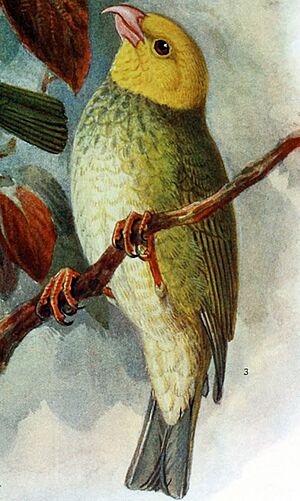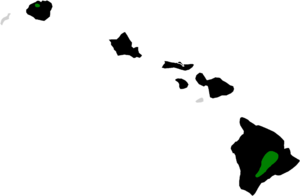ʻŌʻū facts for kids
Quick facts for kids ʻŌʻū |
|
|---|---|
 |
|
| Keulemans illustration | |
| Conservation status | |
| Scientific classification | |
| Genus: |
Psittirostra
|
| Species: |
psittacea
|
 |
|
| Black: Extinct Green: Current range |
|
The ʻōʻū (pronounced oh-OH-oo) (Psittirostra psittacea) was a special bird from the Hawaiian islands. It is a type of Hawaiian honeycreeper. This means it was found only in Hawaii.
The `Ōʻū` had a dark green back and olive green belly. Male `Ōʻū` birds had a yellow head. Female `Ōʻū` birds had a green head. Its unique beak was perfect for eating fruits from the Freycinetia arborea vine. The bird could fly long distances to find these fruits. It also ate other fruits, buds, flowers, and insects.
The `Ōʻū` used to live all over the Hawaiian islands. But its numbers dropped a lot during the 1900s. The International Union for Conservation of Nature lists the `Ōʻū` as Critically Endangered. This means it is very close to disappearing forever. There have been no recent sightings. The bird might already be extinct. The last time anyone saw an `Ōʻū` was in 1989. The U.S. Fish and Wildlife Service said the species was extinct in 2022.
What the `Ōʻū` Looked Like
The `Ōʻū` was a large, plump forest bird. It was about 17 centimetres (6.7 in) long. Male `Ōʻū` birds had a bright yellow head. They also had a dark green back and an olive-green belly. Female `Ōʻū` birds were not as bright. They had an olive-green head.
The `Ōʻū` had a pink, finch-like beak and pink legs. It looked a lot like a parrot. Its scientific name, Psittirostra psittacea, uses "psitta." This word means "parrot" in Greek.
`Ōʻū` Behavior
We do not know much about how `Ōʻū` birds had babies. But young birds were seen in June. This suggests they probably nested between March and May. The `Ōʻū` made a whistling sound. This sound could go up or down. Sometimes, it would turn into a sweet song. It sounded a bit like a canary.
Its special beak was made for eating the fruits of the ʻieʻie (Freycinetia arborea) vine. When these fruits were not in season, the `Ōʻū` would move to find other foods. It ate both native and introduced plants. Besides fruits, it also ate insects. It enjoyed buds and blossoms from the ʻōhiʻa lehua (Metrosideros polymorpha) tree. The `Ōʻū` was known to travel far. It would fly to different areas to find fruits that were ready to eat.
Why the `Ōʻū` Disappeared
The `Ōʻū` used to be common on the six biggest Hawaiian islands. But its population dropped quickly starting in the early 1900s. The last confirmed sighting was in 1989. This happened on Kauaʻi. It is almost certainly extinct there.
Sometimes, people report seeing the `Ōʻū` near the Kīlauea volcano. This is on the island of Hawaiʻi. Because of these reports, groups like The Nature Conservancy still list it as Possibly Extinct. They want to be sure it is gone before calling it fully extinct.
A large group of `Ōʻū` birds lived above Waiākea. But in 1984, a lava flow from Mauna Loa destroyed their home. The `Ōʻū` lived in the mid-elevation ʻōhiʻa lehua forests. These forests were on the Big Island and in the Alakaʻi Wilderness Preserve on Kauaʻi. Later, they lived only in ʻōhiʻa lehua forests.
The `Ōʻū` was one of the most mobile Hawaiian honeycreepers. It was not very active and moved slowly most of the time. But it had amazing strength. When it flew, it could cover very long distances. It was one of the few Hawaiian birds that lived on all the main islands. It did not form different subspecies. This suggests that birds flew between islands often.
Also, the `Ōʻū` moved between different altitudes during the year. This depended on where its favorite food was available. This food was the fruits of the ʻieʻie (Freycinetia arborea) vine. This movement might have been bad for the bird. It meant the `Ōʻū` came into contact with mosquitoes. These mosquitoes carried bird diseases like avian malaria and fowlpox. These diseases are very deadly to most Hawaiian honeycreepers.
Other big threats to the `Ōʻū` were losing its home and new animals brought to the islands. These new animals hunted the birds. Island species are often in danger. This is because they have small numbers and live in small areas.
Protection Efforts
The `Ōʻū` was listed as an endangered species in 1967. This was under the Endangered Species Act. Plans were made to help the Kauaʻi Forest Birds in 1983. Plans for the Hawaiʻi Forest Birds came out in 1984.
These plans suggested ways to protect the land. They wanted to control new plants and animals that were not native. They also wanted to watch new building projects closely. This was to stop more destruction of the birds' homes. The plans also suggested raising the birds in captivity. The `Ōʻū` was last seen in the `Ōlaʻa area. This area is on the Big Island. Today, this area is protected by different groups. These include state, federal, and private organizations.




